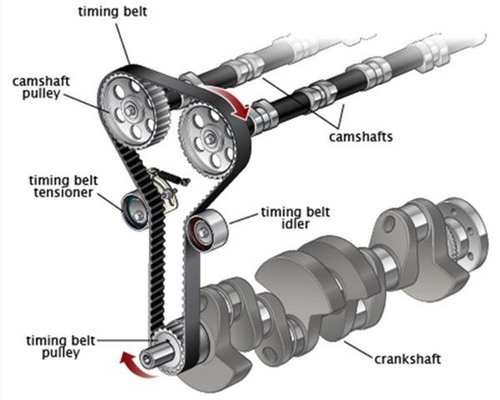What Do I need to Know about Timing Belts?
Most internal combustion engines utilize a similar design, with a crankshaft at the bottom, and a camshaft above it. Both of these shafts spin, with the crankshaft being connected to the pistons; rotating as the pistons move up and down. The camshaft uses a series of lobes to open and close the valves, which let air in and out of your engine.
Since it’s crucial that the valves open and close at the correct time, the crankshaft and camshaft are connected by a timing belt, or timing chain. If this valve timing is not correct, the engine will perform poorly – or worse, may damage itself.
If your car is equipped with a timing belt, it is the single most important maintenance item on your vehicle.
Engines come in two configurations: Interference and non-interference. When a timing belt fails the camshaft(s) stops turning and the valves stop moving, but the crankshaft still rotates for a few seconds. An interference engine has insufficient clearance between the valves and pistons. Because the crankshaft keeps rotating, pistons will slam into any valves stuck in the open position, causing catastrophic engine damage. A timing belt failure in a non-interference engine will leave you inconveniently stranded.
Timing belts are a maintenance item; they can wear out and fail without warning. Check your owner’s manual. It pays to know which kind of engine you have and the recommended replacement intervals.
WHAT A TIMING BELT IS MADE OF
According to Autozone, “Modern timing belts are constructed of rubber, synthetic rubbers like neoprene, polyurethane, or highly saturated nitrile, with high-tensile strength reinforcing cords made of Kevlar, polyester, or fibreglass."
The reinforcing cords will run the length of the belt, to reduce the tendency of the belt to stretch out over time. Timing belts have trapezoidal or curvilinear teeth cut into one of the sides and these teeth are specially shaped and sized to connect properly with the pulleys on the crankshaft and the camshaft.
Engines with timing chains will have oil flowing over the chain to lubricate and protect the parts. Oil can damage rubber, so engines with rubber timing belts will typically be constructed in a “dry” setup, where oil or coolant does not interact with the belt.
SIGNS YOUR CAR NEEDS A NEW TIMING BELT
No matter if you have a timing chain or a rubber belt under your hood, problems with either part are easy to notice. Here are problems with a timing belt you can look out for:
- The engine misfires
- Ticking noise coming from the engine
- Oil leaks from the front of the motor
- The engine acts up between 2000 – 4000 RPM
- More smoke and fumes than normal
- The engine won’t turn over
WHAT HAPPENS WHEN A TIMING BELT FAILS?
A timing belt that is past its expiry date will eventually break. A broken timing belt is never a good situation; one that we wouldn’t wish on any driver. Besides causing an inconvenient break-down, a broken timing belt can cause considerable damage to the engine. This is because most modern engines use an interference head design, where the pistons can actually contact the valves if the valve timing is not correct. This usually results in thousands of dollars of engine damage in the form of bent valves; broken pistons; etc.
Repairing the damage that results from a broken timing belt can sometimes cost more than the vehicle is worth; instantly rendering your vehicle almost worthless. The only way to avoid this situation is to replace your timing belt on time, every time.

Here’s an example of engine damage from a broken timing belt: one of the valves in this engine came into contact with a piston; broke off; and was pummeled into the cylinder head.
Stop by Hillside Auto Repair today if you think your timing belt is worn or if you want to get an idea of how often you should replace the belt. Our friendly and knowledgeable team will help educate you on the best time to replace your timing belt as recommended by your vehicle manufacturer. We care. Because We are The Professionals You Can Trust!